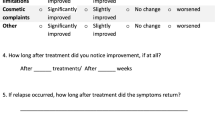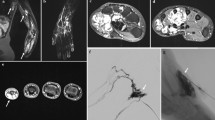Abstract
The aim of this study was to retrospectively evaluate the safety and efficacy of polidocanol sclerotherapy in pain relief for painful venous malformations (VMs). Thirty-one patients with painful VMs underwent polidocanol sclerotherapy. Pain intensity was assessed with an 11-point verbal numerical rating scale. Sclerotherapy was technically successful in 58 (98.3%) of 59 sessions. Twenty-six (89.7%) out of 29 patients experienced an improvement in pain after sclerotherapy at follow-up, a mean of 46 months after treatment. The mean pain score improved from 6.6 ± 2.5 before treatment to 2.4 ± 2.9 after treatment (P <.001). The factors that significantly influenced the therapeutic effect were size of lesion (P = .008), margin of lesion (P = .006), and stasis of sclerosant (P = .032). Adverse events included hypotension and bradycardia during the procedure. No major complication occurred. Polidocanol sclerotherapy is safe and most efficacious in providing pain relief for patients with small VMs (equal to or less than 10 cm in diameter), VMs with a well-defined margin, and VMs with good stasis of sclerosant during sclerotherapy.


Similar content being viewed by others
References
Yakes WF, Luethke JM, Parker SH et al (1990) Ethanol embolization of vascular malformations. Radiographics 10:787–796
Yakes WF (1994) Extremity venous malformations diagnosis and management. Seminars in interventional radiology 11:332–339
Shireman PK, McCarthy WJ, Yao JS et al (1997) Treatment of venous malformations by direct injection with ethanol. J Vasc Surg 26:838–844
Donnelly LF, Bissett GS 3rd, Adams DM (1999) Combined sonographic and fluoroscopic guidance: a modified technique for percutaneous sclerosis of low-flow vascular malformations. Am J Roentgenol 173:655–657
Burrows PE, Mason KP (2004) Percutaneous treatment of low flow vascular malformations. J Vasc Interv Radiol 15:431–445
Berenguer B, Burrows PE, Zurakowski D et al (1999) Sclerotherapy of craniofacial venous malformations: complications and results. Plast Reconstr Surg 104:1–11
Lee BB, Do YS, Byun HS et al (2003) Advanced management of venous malformation with ethanol sclerotherapy: mid-term results. J Vasc Surg 37:533–538
Suh JS, Shin KH, Na JB et al (1997) Venous malformations: sclerotherapy with a mixture of ethanol and lipiodol. Cardiovasc Intervent Radiol 20:268–273
Goyal M, Causer PA, Armstrong D (2002) Venous vascular malformations in pediatric patients: comparison of results of alcohol sclerotherapy with proposed MR imaging classification. Radiology 223:639–644
O’Donovan JC, Donaldson JS, Morello FP et al (1997) Symptomatic hemangiomas and venous malformations in infants, children, and young adults: treatment with percutaneous injection of sodium tetradecyl sulfate. Am J Roentgenol 169:723–729
Dubois JM, Sebag GH, De Prost Y et al (1991) Soft-tissue venous malformations in children: percutaneous sclerotherapy with Ethibloc. Radiology 180:195–198
Riche MC, Hadjean E, Tran-Ba-Huy P et al (1983) The treatment of capillary-venous malformations using a new fibrosing agent. Plast Reconstr Surg 71:607–614
Choi YH, Han MH, O-Ki K et al (2002) Craniofacial cavernous venous malformations: percutaneous sclerotherapy with use of ethanolamine oleate. J Vasc Interv Radiol. 13:475–482
Yamaki T, Nozaki M, Sasaki K (2000) Color duplex-guided sclerotherapy for the treatment of venous malformations. Dermatol Surg 26:323–328
Jain R, Bandhu S, Sawhney S et al (2002) Sonographically guided percutaneous sclerosis using 1% polidocanol in the treatment of vascular malformations. J Clin Ultrasound 30:416–423
Cabrera J, Cabrera J Jr., Garcia-Olmedo MA et al (2003) Treatment of venous malformations with sclerosant in microfoam form. Arch Dermatol 139:1409–1416
Mol W, Furukawa H, Sasaki S et al (2007) Evaluation of the sclerotherapeutic efficacy of ethanol, polidocanol, and OK-432 using an in vitro model. Dermatol Surg 33:1452–1459
Meyer JS, Hoffer FA, Barnes PD et al (1991) Biological classification of soft-tissue vascular anomalies: MR correlation. Am J Roentgenol 157:559–564
Rak KM, Yakes WF, Ray RL et al (1992) MR imaging of symptomatic peripheral vascular malformations. Am J Roentgenol 159:107–112
Dubois J, Soulez G, Oliva VL et al (2001) Soft-tissue venous malformations in adult patients: imaging and therapeutic issues. Radiographics 21:1519–1531
Mulliken JB, Glowacki J (1982) Hemangiomas and vascular malformations in infants and children: a classification based on endothelial characteristics. Plast Reconstr Surg 69:412–422
Enjolras O (1997) Classification and management of the various superficial vascular anomalies: hemangiomas and vascular malformations. J Dermatol 24:701–710
Sacks D, McClenny TE, Cardella JF et al (2003) Society of interventional radiology clinical practice guidelines. J Vasc Interv Radiol 14:S199–S202
Marrocco-Trischitta MM, Guerrini P, Abeni D et al (2002) Reversible cardiac arrest after polidocanol sclerotherapy of peripheral venous malformation. Dermatol Surg 28:153–155
Feied CF, Jackson JJ, Bren TS et al (1994) Allergic reactions to polidocanol for vein sclerosis. Two case reports. J Dermatol Surg Oncol 20:466–468
Author information
Authors and Affiliations
Corresponding author
Rights and permissions
About this article
Cite this article
Mimura, H., Fujiwara, H., Hiraki, T. et al. Polidocanol sclerotherapy for painful venous malformations: evaluation of safety and efficacy in pain relief. Eur Radiol 19, 2474–2480 (2009). https://doi.org/10.1007/s00330-009-1442-2
Received:
Revised:
Accepted:
Published:
Issue Date:
DOI: https://doi.org/10.1007/s00330-009-1442-2




